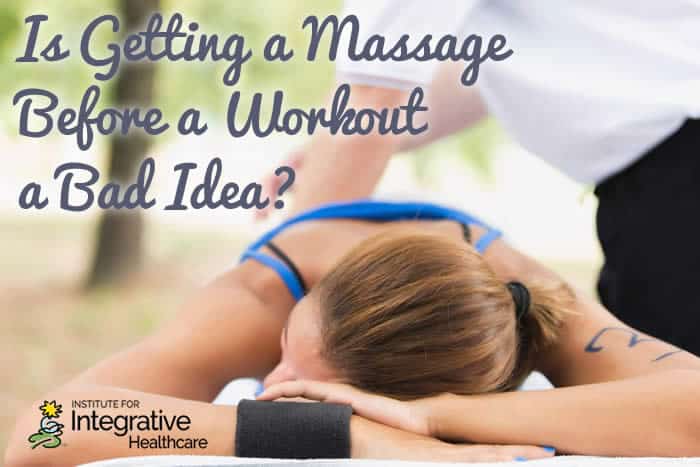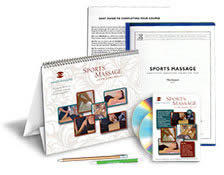

In reality, there doesn’t seem to be a simple answer to this question. The research is mixed but, it seems that, at least in part, it depends on the type and duration of the massage, what the preferred outcome is, and what effects are being measured.
It’s therefore important to ask, as a starting point for decision making, what you expect the massage to do for you.
Is the Massage Intended to Improve Athletic Performance?
Athletes from sports as wide ranging as football (e.g., Tom Brady, Julian Edelman) and track (Allyson Felix) all swear that the massages they receive just before participating in their respective sporting events improve their performance (1, 2, 3). The research, however, does not, in the main, seem to support this belief. Several studies have found that a massage just prior to athletic performance had no effect on strength, jump height, speed, and agility (4, 5, 6); while other studies found that pre-event massage actually had a negative impact on vertical jump, speed, reaction time, and muscle performance generally (7, 8). Researchers at the University of Granada in Spain concluded that this negative impact is “possibly because of increased parasympathetic nervous system activity” (8).
At least one study, though, found that although massage administered immediately before a physical feat did not improve performance (in this case, height of a vertical jump), even the short passage of time—as little as 11 or 16 minutes—did show improvements, with the majority of the small sample showing greater vertical jump height after some time had passed (9). Such contradictory results point to the relative newness of this area of research and suggest that more research needs to be done.
Another study found that massage before physical activity demonstrated a significant decrease in fatigue (5). Initially, I thought this finding was contradictory to the results of a study that showed massage to have no impact on endurance (6). It turns out that in the former case, “fatigue” was a psychological state, as measured by the Profile of Mood States questionnaire (5), whereas as “endurance” was a quantitative measure of the performance of a task related to badminton, the sport being studied (6).
But what about stretching? Many people—coaches, trainers, athletes, and physical therapists among them—believe that “if you do enough stretches and mobility exercises, you’ll be able to move pain free, avoid injury, and perform better” (10). And some massage therapists suggest that receiving a sports massage that incorporates stretching before you engage in physical activity not only will make you a better athlete but will also reduce the likelihood of injury, such as a pulled or strained muscle (11).
In fact, however, research shows that stretching before becoming physically active does not protect you either from physical injury or from muscle soreness (12, 13). As for performing better, unless you’re a dancer, acrobat, or gymnast, where flexibility is key, stretching will likely either have a negative impact on performance or no effect at all (14). Static stretches prior to exercise have been shown to reduce the speed of sprinters (15), slow a runner’s start (16), decrease vertical jump height (17), and reduce mean power output (18), to give just a few examples. However, even the author of an article on why stretching is completely overrated points out that stretching “feels good. . . . As long as you aren’t doing it immediately before exercise, and you don’t hold it for too long, there’s little evidence stretching will interfere with your performance. If you think it feels good, do it. Just remember why you’re doing it” (10).
Warming the muscles to reduce the risk of injury is claimed as another positive outcome of a pre-event massage (11, 19). A 2006 review of the literature on the value of warming muscles prior to exercise concluded there was not yet enough evidence to endorse or discredit warming up beforehand but found that “the weight of evidence is in favour of a decreased risk of injury” (20). According to the author of the book Self-Massage for Athletes, a pre-workout massage should be short (about 5–10 minutes) and should use “light, stimulating, drumming strokes and gliding strokes of light to moderate pressure” to warm the skin and increase heart rate (19).
Is the Massage Intended to Relieve Performance Anxiety?
The psychological aspects may actually be the biggest benefit of massage before physical activity. Even studies that found no or negative physiological effects following massage indicated that there were, nonetheless, psychological benefits to a pre-event massage (5, 6, 8, 21), and a study whose objective was to examine the effect of massage on the anxiety of soccer players before World Cup matches found that the anxiety was, in fact, reduced (22). According to one author, a light pre-workout massage connects your conscious thoughts with your body, thereby centering your attention, which reduces stress and anxiety and increases self-confidence (19).
Is the Massage Intended for Therapeutic Purposes or Relaxation?
A therapeutic massage is any massage designed to address a specific problem, such as muscle pain and soreness from working out or such as a repetitive stress injury. It can include a variety of techniques, from cross-fiber friction and muscle stripping to myofascial release and effleurage. Any of the more intense techniques, such as cross-fiber friction and muscle stripping, are believed to cause micro-tears in the muscle fibers, much like those you get from a strenuous workout (23, 24), which may account for some of the soreness that is sometimes reported by clients following a massage (25). That soreness can last up to 24 hours (25), so a therapeutic massage is not something you should schedule right before working out.
Even if you don’t experience muscle soreness, there’s a chance that a longer massage, whether therapeutic or for relaxation, will make you feel fatigued (23, 25, 26), increasing the risk of getting hurt if you workout afterward or simply making you so relaxed that you lose your motivation (23).
To Be Massaged or Not to Be Massaged?
The scarcity of research on specific types of massage and their impact on athletic performance and conditioning makes it difficult to offer guidance on the matter with any degree of certainty. But based on the research so far, it seems relatively safe to say the following:
- DO get pre-workout massage if it is short (approx. 10–15 minutes long)
- DO NOT get a pre-workout massage that uses intense therapeutic techniques
- DO get a pre-workout massage if you want to reduce your anxiety or stress level before an event
- DO NOT expect a pre-event massage to improve your performance
- DO get a massage with stimulating drumming or gliding strokes of light to moderate pressure














